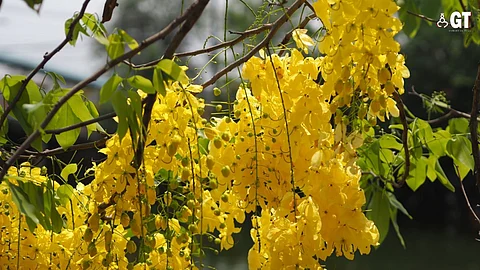

The butter yellow bunches of flowers, that began appearing in January, are now drawing attention of the people across Goa.
It is the amaltas or Cassia fistula, which grabs one’s attention near the old South Goa Collectorate building, with its flowers hanging like grape bunches, and making the tree canopy look more yellow than green.
There are trees in Panjim and other places, too, but the cluster of trees in the Aga Khan Municipal Garden, in Margao, makes it stand out.
There is a tree at the Patto end of the bridge connecting to Mala-Fontainhas, and plenty more in the Joggers’ Park at Altinho in Panjim. There are amaltas trees all over Goa, and we call them Bava or Bayo in amchi bhas, Konkani.
It is not uncommon to see amaltas in home gardens. The tree is a native of India and South-East Asia.
The amaltas is a beautiful ornamental tree. The flower bunches are especially attractive at sunrise and sunset in springtime and early summer.
The lake-side garden, near the rajwada of the Bhonsales of Sawantwadi, has a large number of amaltas trees and is a sight to behold from now till the end of April.
It is the state flower of Kerala and is used in the rituals of the Vishu festival. It is the national tree and national flower of Thailand.
In Laos, the amaltas flower is associated with the Lao New Year, and flowers are hung in houses to signify peace and prosperity.
The leaves are compound, pinnate with three to eight pairs of leaflets. These leaflets are large enough to be confused as simple leaves. The tree is deciduous like the Gulmohar and sheds leaves at the time of flowering in springtime to give it its stunning golden beauty.
Besides human beings, these flowers attract bees. It is a good source of nectar and pollen for honey bees and carpenter bees. Honey bee activity promotes pollination of its attractive bunches of flowers!
The amaltas is often called Golder Shower Tree, but should not be confused with the golden shower creeper, Pyrostegia ignea or Bignonia venusta which belongs to the Bignonia family.
They are unrelated. The flowers are edible for human consumption while the leaves are fodder for cattle and goats.
It is also known as ‘pudding-pipe tree’ because of its long pods, and also as the ‘purging cassia’ because the fruit pulp is used as a herbal purgative. Caution is advised when using the fruit pulp, even for ayurvedic purposes.
The pod that gives it the name ‘pudding-pipe’ has numerous flat disc-like seeds stacked like casino chips or coins in a counting house. These seeds need to be extracted, soaked in water and sown in bags to raise seedlings.
The tree grows easily in hot tropics and sub-tropics. It is drought tolerant, but cannot withstand waterlogging. It can grow in marginal soil, but needs good sunlight. Initially, slow-growing, it is a medium-sized tree with a spreading canopy.
Seedlings of this tree are raised by the Goa Forest Department and are available at its nurseries during the planting season of June and July each year. Why not get one and plant it near your home?
The author is the former Chairman of the GCCI Agriculture Committee, CEO of Planter's Choice Pvt Ltd, Additional Director of OFAI and Garden Superintendent of Goa University, and has edited 18 books for Goa & Konkan